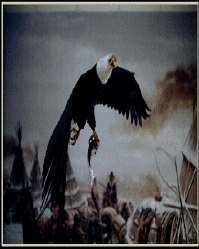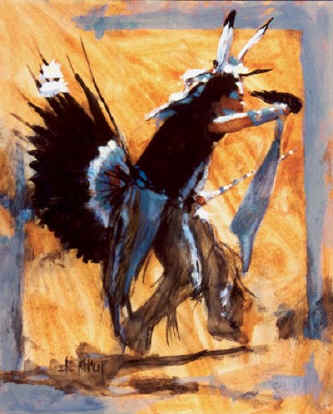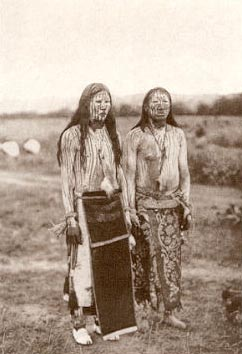|

|
|
''The
Sun-Dance is supposed to re-create, reform, to reanimate the earth, |
|
vegetation,
animal life, and is a ceremony of rebirth or renaissance''. |
|
Dorsey 1905 |
|
The
Religious Meaning |
| The Sun Dance is usually held once a year though in some
tribes it is held very seldom. This Dance is a very religious and communal
ceremony. It is the most celebrated, Spectacular, and meaningful ceremony known to
the plains Indians. The Sun-Dance shows
equality in life. And between all of nature. It shows that there is no true end
to life, only spiritual deaths and rebirths. The most renowned priest is
also the best lodge maker. This person ran the entire ceremony of
the Sun-Dance. |
|
The Eagle |
| There were very many animals involved in the
Sun -Dance that had very high symbolistic meaning. The eagle was
among those many animals. The Eagle is highly symbolistic, sacred,
and important. The Eagles nest is placed at the top of the fork of
the lodge. In Arapaho mythology the nest represents the Eagle
(Thunder-bird) who built his nest in a cotton wood tree near the village
of the Indians during a time of despair. The Crow , and Shoshone fasten an
actual golden Eagle head to the entrance of the dance. The Eagle was
considered the ''Chief'' of all animals in the sky or nest. And a
very powerful animal in battle. The Eagle is admired for courage,
Swiftness, and Strength. The Eagle is believed protect the people
from harm, devastation, or any kind of evil. It is also said that
the Eagle is the carrier of all messages from Wakan -Tanka (GOD) to the
people, or from the people to Wakan-Tanka. The bird kept the
connection between the people and all super natural
forces. |
 \ \
Bald
Eagle
|
|
| During the Sun-Dance it was tradition for each dancer to
blow on a whistle made from the wing bone of an Eagle. Making the
sound of an Eagle cry. Always keeping time with the drum. The
whistle is painted with colored dots and lines to represent the remarkable
perception of the Eagle. There is also a beautiful feather attached
to the end of the whistle. The feather blew back and forth
representing the breath of life. ''In an Eagle there is all the
wisdom of the world'' (Lame deer and Erdoes 1972) |
|
The Buffalo |
| The Buffalo is also one of the many animals
worshiped in the Sun-Dance. The Buffalo is known to be the very
source of life for the plains Indians. The Buffalo is said to
radiate power. They are also very important because the migration of
the heard determines where and when the Sun-Dance will be held. Many
songs are sung as the dance progresses changing in tempo and speed.
To resemble the sound of a Buffalo heard traveling across the prairie. ''
The buffalo symbolizes the necessities without witch life would be hazardous
and wearisome. and also bestows great curing powers'' and ''Still
radiates power''. (Vogal 1984). |
| The Lakota placed a dried Buffalo
penis on the sun pole to give the dancers virility. It also reinforced
the point of the ceremony by drawing attention to the power of the
sun. ''All will be harmonized wit the potency of the Buffalo god,
That should prevail during the ceremony''. ( Walker 1980)
There were many other kinds of animals involved in the Sun-Dance
also. The Sun-Dancers sometimes wore rabbit skins on their arms and
legs. The rabbit was admired for quickness, slyness, and for its
extreme cleverness. |

|
|
The Dance |
| The Sun-Dancers danced in an enclosed
area around or facing the sun pole, always facing the sun. As a rule
the Sun-Dancers went without food or water for the whole time the sun dance
was going on. Witch sometimes lasted ten or more days. Or until
the dancer had a vision. A row of young maidens would appear
on the other side of the arena and add their voices to the rough voices of
the warriors. The dancing happened in intervals of ten minuets with
breaks of equal length. |
|
Torture |
| There where many forms of torture,
self torture was one of them. A row of dancers took their places
promptly at sunrise but it was nine or ten before the torture actually
began. Generally in two or three hours the victim is freed but in
many cases double or even triple that time is required. The warriors
chosen were between the age of twenty and twenty-five. They were
also the best warriors available. The warriors would have two slits
cut in their skin. A skewer would be put in the skin with a string
attached to it that is also attached to the sun pole that was in the
middle of the ring. Then the warriors would jerk back and forth to
try to get the skin around the skewer to tear away setting the warrior
free. |
|
The
Sun Pole |
| The center pole is a very important
part of the sun-dance. A tree was selected, The leaves where cut
from the top of the tree. Then the tree was stood upright, being
held by ropes made of buffalo thongs. The ropes were fastened to
stakes in the ground placed about eighty feet away from the actual Sun
Pole. These ropes along with
several others that were closer to the Sun Pole together made a large
circle. Stretched over the stakes were Elk and Buffalo skin, bundles
of brush, and blankets. Sometimes canvas was thrown over the
supporting ropes meant to block the sun though doing very little
good. The eldest woman would lead a group of young maidens to strip
the tree of its branches, to prepare it for the dance. The fallen
tree was treated just like a fallen enemy. A bundle was placed at
the fork of the tree. The bundle contained Buffalo Hide, Straws full
of Tobacco, and other religious offerings. |
|
The Ending of the
Sun-Dance |
| The ending of
the Sun-Dance came in 1904 allegedly because of the self torture.
The Dance was forbidden even if there was no self torture of any kind
involved. though there were many tribes that tried to revive the
Sun-Dance and celebrate it in its original form and meaning.. |
|
Tribes |
| The tribes
that were involved in the Sun-Dance were, The Arapaho, Gros, Asbinboine,
Cheyenne, Crow, Ventre, Hidusta, Sioux, Plains Cree, Plains Ojibwa,
Sarasi, Omaha, Ponca, Ute, Shoshone, Kiowa, and Blackfoot tribes.
Their rituals varied from tribe to tribe. |

Two Warriors of the Sioux tribe. |
|
|
Jodi
Reamer
8th
American history
Rossville
Jr. High
Plain
History Project
2004
|
Bibliography |
|
| Revised:
February 05, 2004 |

 \
\
